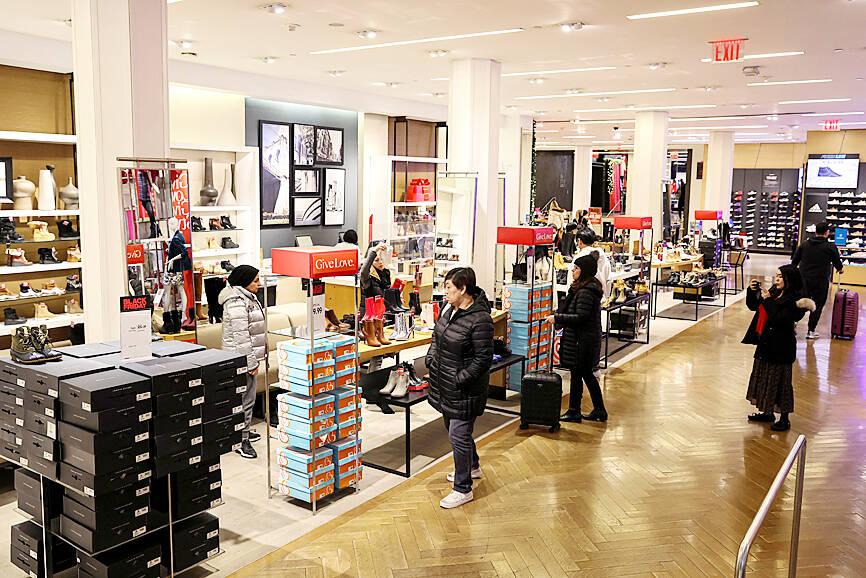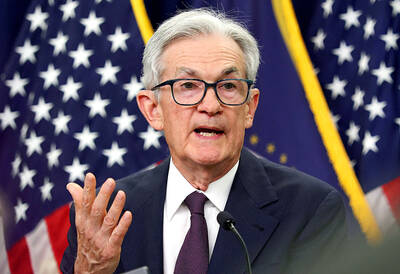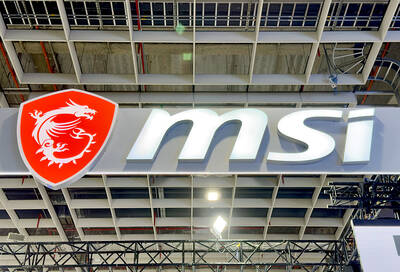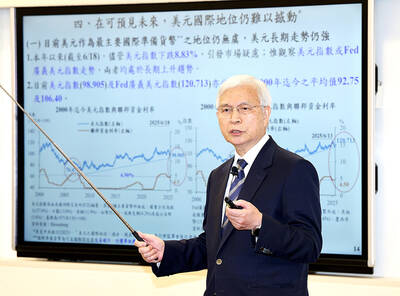US retailers discounted heavily on Black Friday to clear out bloated inventories, but customers responded with only modest traffic, leaving profitability in doubt for many chains.
Brick-and-mortar retailers, which were hit hard by COVID-19 closures and shoppers seeking to avoid the virus, saw in-store traffic on Friday tick up 2.9 percent from last year’s shopping event, data compiled by Sensormatic Solutions showed.
US consumers are still spending, but they are growing more cautious after contending this year with the highest inflation rates in four decades. They are also keeping a sharper lookout for deals, and retailers — many of them still heavy with inventory after misjudging an erosion in demand — are trying to stand out by dangling the deepest discounts since before the COVID-19 pandemic.

Photo: Reuters
The US holiday shopping season is likely to see modest or break-even growth in annual sales, said Melissa Minkow, director of retail strategy at digital consultancy CI&T Inc.
“That’s still a win,” she said, contrasting the outlook with the UK, where high inflation has caused consumers to pull back noticeably on spending.
Still, the steep Black Friday discounts are likely to squeeze retailers.
“Profits will not be where retailers want them to be,” in part because they “couldn’t pass all of the inflationary costs off to consumers,” Minkow said.
E-commerce spending on Black Friday rose 2.3 percent to US$9.12 billion, Adobe Analytics data showed.
That is far less than the US inflation rate of almost 8 percent during the 12 months ending last month.
Salesforce Inc said the average consumer discount on Black Friday was expected to be greater than 30 percent, up from 28 percent last year and close to the 33 percent rate in 2019.
“People are just plainly buying less products because their dollar isn’t going as far,” Salesforce vice president of retail Rob Garf said.
At Crossgates Mall in Albany, New York, low-cost brands and higher-end trendy retailers had the most foot traffic, while middle-market stores were desolate.
Gap Inc’s Old Navy, which was offering 60 percent off most items, had a checkout lines so long that some shoppers turned around as soon as they entered the store.
Drawing big crowds at the higher end were leisure athletic-wear favorite Lululemon Athletica Inc, which had only a few racks of discounted merchandise, and American Eagle Outfitters Inc’s Aerie, a popular intimates brand among Generation Z shoppers.
Meanwhile, stores such as Gap’s Banana Republic, Macy’s Inc and Urban Outfitters Inc had no lines at all, and only a handful of shoppers.
The healthy traffic at some retailers shows that many US consumers are still spending at a robust clip.
US retail sales on Friday were up 12 percent year-on-year, excluding automotive, according to Mastercard SpendingPulse, which measures in-store and online purchases across all forms of payment.
The spending increase is not adjusted for inflation.
However, crowds appeared to be an exception. The checkout line at the toy section at a Macy’s in Stamford, Connecticut, had no wait, and the cashier said the store had prepared for more shoppers. A Walmart in suburban Dallas also had cashiers standing at the ready with no lines.
“The historic raucous atmosphere of Black Friday may be in the past,” as more consumers shop online and spread their spending out over a longer period, Piper Sandler Cos retail analyst Edward Yruma said in a report.

DIVIDED VIEWS: Although the Fed agreed on holding rates steady, some officials see no rate cuts for this year, while 10 policymakers foresee two or more cuts There are a lot of unknowns about the outlook for the economy and interest rates, but US Federal Reserve Chair Jerome Powell signaled at least one thing seems certain: Higher prices are coming. Fed policymakers voted unanimously to hold interest rates steady at a range of 4.25 percent to 4.50 percent for a fourth straight meeting on Wednesday, as they await clarity on whether tariffs would leave a one-time or more lasting mark on inflation. Powell said it is still unclear how much of the bill would fall on the shoulders of consumers, but he expects to learn more about tariffs

Meta Platforms Inc offered US$100 million bonuses to OpenAI employees in an unsuccessful bid to poach the ChatGPT maker’s talent and strengthen its own generative artificial intelligence (AI) teams, OpenAI CEO Sam Altman has said. Facebook’s parent company — a competitor of OpenAI — also offered “giant” annual salaries exceeding US$100 million to OpenAI staffers, Altman said in an interview on the Uncapped with Jack Altman podcast released on Tuesday. “It is crazy,” Sam Altman told his brother Jack in the interview. “I’m really happy that at least so far none of our best people have decided to take them

PLANS: MSI is also planning to upgrade its service center in the Netherlands Micro-Star International Co (MSI, 微星) yesterday said it plans to set up a server assembly line at its Poland service center this year at the earliest. The computer and peripherals manufacturer expects that the new server assembly line would shorten transportation times in shipments to European countries, a company spokesperson told the Taipei Times by telephone. MSI manufactures motherboards, graphics cards, notebook computers, servers, optical storage devices and communication devices. The company operates plants in Taiwan and China, and runs a global network of service centers. The company is also considering upgrading its service center in the Netherlands into a

NOT JUSTIFIED: The bank’s governor said there would only be a rate cut if inflation falls below 1.5% and economic conditions deteriorate, which have not been detected The central bank yesterday kept its key interest rates unchanged for a fifth consecutive quarter, aligning with market expectations, while slightly lowering its inflation outlook amid signs of cooling price pressures. The move came after the US Federal Reserve held rates steady overnight, despite pressure from US President Donald Trump to cut borrowing costs. Central bank board members unanimously voted to maintain the discount rate at 2 percent, the secured loan rate at 2.375 percent and the overnight lending rate at 4.25 percent. “We consider the policy decision appropriate, although it suggests tightening leaning after factoring in slackening inflation and stable GDP growth,”